Early repolarization
Editor-In-Chief: C. Michael Gibson, M.S., M.D. [1]; Associate Editor(s)-In-Chief: Rim Halaby
Synonyms and keywords: early repolarization pattern; early repol; early repol variant
Overview
Early repolarization is defined as either a notch described as a positive deflection after a positive QRS segment or a J point elevation of more than 0.1 mV in at least two consecutive leads. While early repolarization has been long considered a normal benign ECG variant, some studies suggest an association between early repolarization and increased risk of arrhythmia, particularly ventricular fibrillation. Moreover, early repolarization pattern must be differentiated from early repolarization syndrome as the former is strictly an EKG finding whereas the latter represents a symptomatic situation of cardiac arrest or syncope following the occurrence of an early repolarization pattern.[1] Early repolarization can be confused with STEMI and pericarditis.
Natural History, Complications and Prognosis
- Early repolarization pattern has been considered benign for a long time until some studies suggested an association between early repolarization and increased risk of arrhythmia, particularly ventricular fibrillation.[1] A possible explanation of the increased vulnerability to ventricular fibrillation associated with early repolarization is that early repolarization might be an indicator of transmural repolarization heterogeneity.[2]
- This association has shed light on the importance of evaluating early repolarization patterns and their prognostic implications. Whereas early repolarization is a common finding, idiopathic ventricular fibrillation is a rare entity which incidence ranges from 3:100000 to 10:100000.
- The majority of early repolarization patterns, especially if incidentally found in otherwise asymptomatic people with a negative family history, have no or minimal increased risk of arrhythmia.
- Early repolarization carries a higher risk of arrhythmia in patients with underlying cardiac pathology.
- Early repolarization is rarely associated with a primary arrythmogenic disorder that manifests as idiopathic ventricular fibrillation. Genetic predisposition seems to play a role in this group of people. In addition, early repolarization seems to cause arrhythmia during sleep or at rest in the absence of any physical activity.[1]
- In addition, early repolarization seems to have different patterns which have different clinical significance. Hence, a standardized evaluation of early repolarization is needed. Early repolarization patterns that demonstrate a rapidly ascending ST segment after the J point are almost always benign.[3]
- A case control study of 120 post MI patients with implantable cardioverter defibrillators (ICDs) demonstrated that early repolarization was more frequently observed among patients with documented episodes of ventricular fibrillation (32% vs. 8%, p=0.005). The leads demonstrating early repolarization were more often the inferior leads (23% vs. 8%, p=0.03). A trend was observed for the lateral leads (V4-V6) as well (12% vs. 3%, p=0.11). In contrast, leads I and aVL were not commonly involved (3% vs. 0%). The morphology of the ST segment was critical and a notch in the ST segment was observed more frequently among patients with ventricular fibrillation (28% vs. 7%, p=0.008). In contrast, J-point elevation and slurring of the ST segment surprisingly were not associated with ventricular arrhythmias.[4]
Differential Diagnosis
Early Repolarization Syndrome
- The terms early repolarization and early repolarization syndrome must be differentiated. Early repolarization is a term used to describe changes noted on ECG regardless of the presence or absence of any symptoms. Early repolarization syndrome is the presence of cardiac arrest, and less frequently syncope, in the absence of any other cause that can explain the early repolarization changes on ECG. The diagnosis of early repolarization syndrome requires ruling out other etiologies that might be responsible for the ECG changes.
- In addition, the symptoms associated with early repolarization syndrome immediately follow the ECG changes.[1]
Other Causes of ST Elevation
Early repolarization must be differentiated from other causes of ST elevation including STEMI and pericarditis.
- The ST segment elevation of early repolarization is exacerbated by bradycardia, carotid sinus massage and vagal maneuvers. This is not true in STEMI or pericarditis.
- Early repolarization is characterized by a notch at the J point which is not a characteristic finding in STEMI or pericarditis. Shown below is an image demonstrating a characteristic notch which is present at the J point in early repolarization.
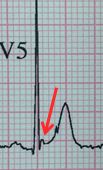
- The height of the J point can be used to differentiate early repolarization from other conditions. Only lead V6 is used to distinguish between early repolarization and pericarditis. As shown in the image below, if A/B > 25%, pericarditis should be suspected. If A/B < 25%, early repolarization is more probable.
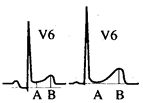
EKG Examples
Shown below is an EKG demonstrating J point elevation, concave shaped up-sloping ST segment, and prominent T waves in the inferior and lateral leads depicting benign early repolarization.
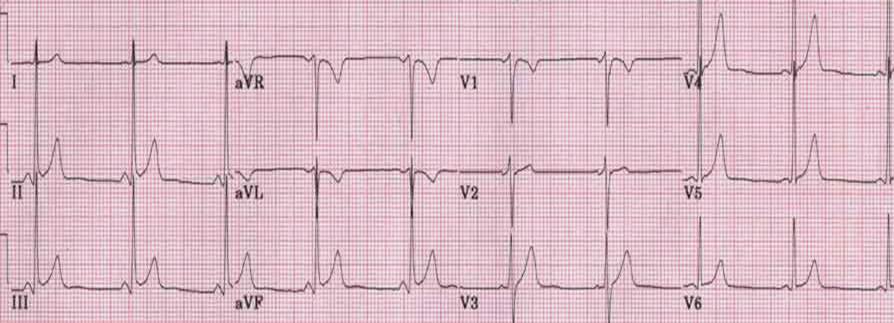
Shown below is an EKG demonstrating notching of the J point in the lateral leads depicting early repolarization.
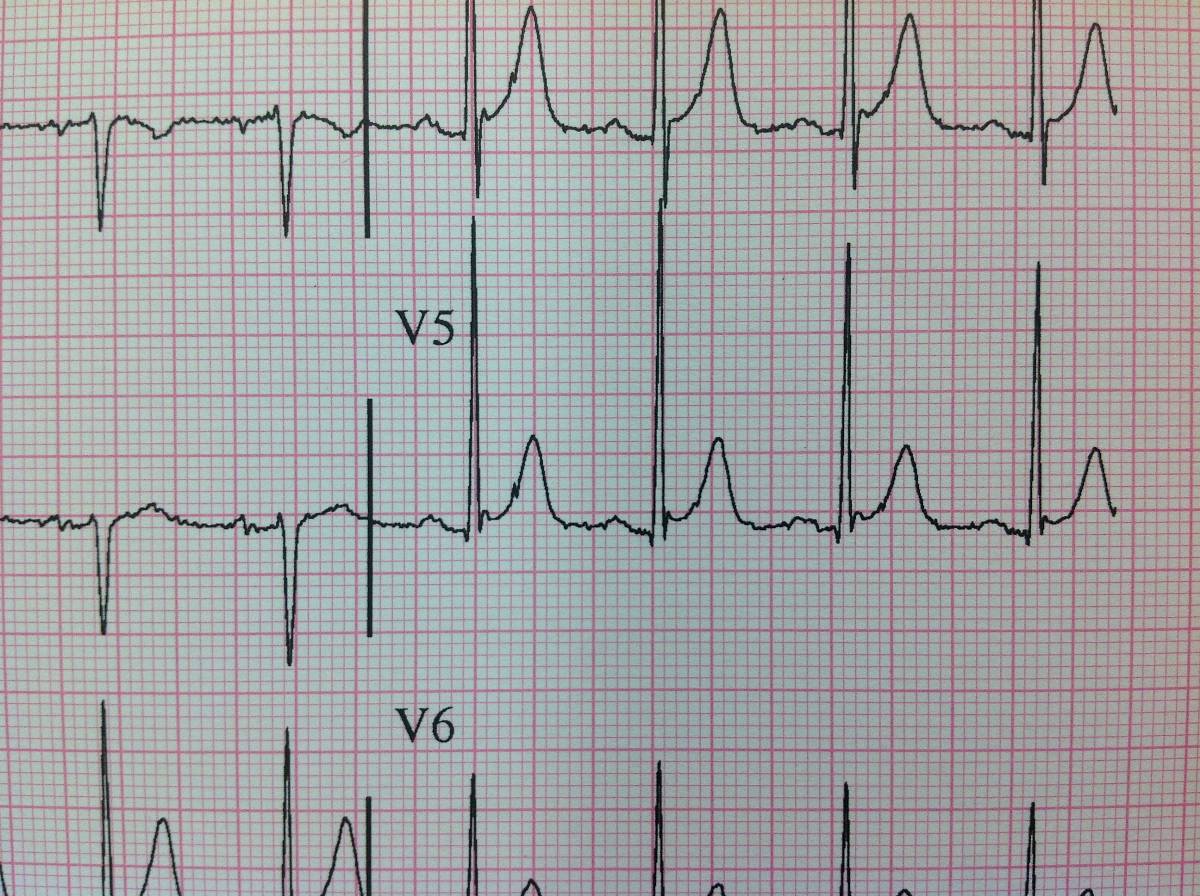
Shown below are examples of EKG depicting early repolarization and other normal variants of ST elevation.
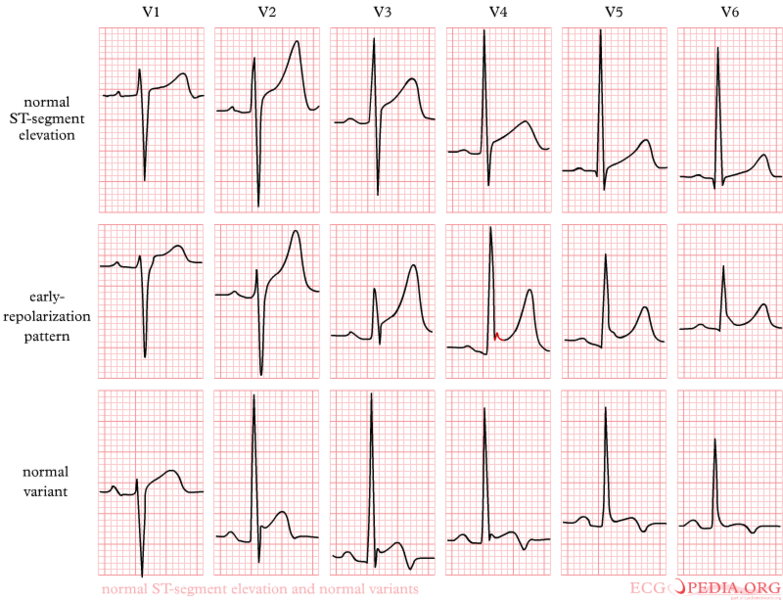
References
- ↑ 1.0 1.1 1.2 1.3 Obeyesekere, MN.; Klein, GJ.; Nattel, S.; Leong-Sit, P.; Gula, LJ.; Skanes, AC.; Yee, R.; Krahn, AD. (2013). "A clinical approach to early repolarization". Circulation. 127 (15): 1620–9. doi:10.1161/CIRCULATIONAHA.112.143149. PMID 23588960. Unknown parameter
|month=ignored (help) - ↑ Wu, SH.; Lin, XX.; Cheng, YJ.; Qiang, CC.; Zhang, J. (2013). "Early repolarization pattern and risk for arrhythmia death: a meta-analysis". J Am Coll Cardiol. 61 (6): 645–50. doi:10.1016/j.jacc.2012.11.023. PMID 23290543. Unknown parameter
|month=ignored (help) - ↑ De Ambroggi, L.; Sorgente, A.; De Ambroggi, G. "Early repolarization pattern: Innocent finding or marker of risk?". J Electrocardiol. 46 (4): 297–301. doi:10.1016/j.jelectrocard.2013.02.008. PMID 23540936.
- ↑ Patel, RB.; Ng, J.; Reddy, V.; Chokshi, M.; Parikh, K.; Subacius, H.; Alsheikh-Ali, AA.; Nguyen, T.; Link, MS. (2010). "Early repolarization associated with ventricular arrhythmias in patients with chronic coronary artery disease". Circ Arrhythm Electrophysiol. 3 (5): 489–95. doi:10.1161/CIRCEP.109.921130. PMID 20657030. Unknown parameter
|month=ignored (help)